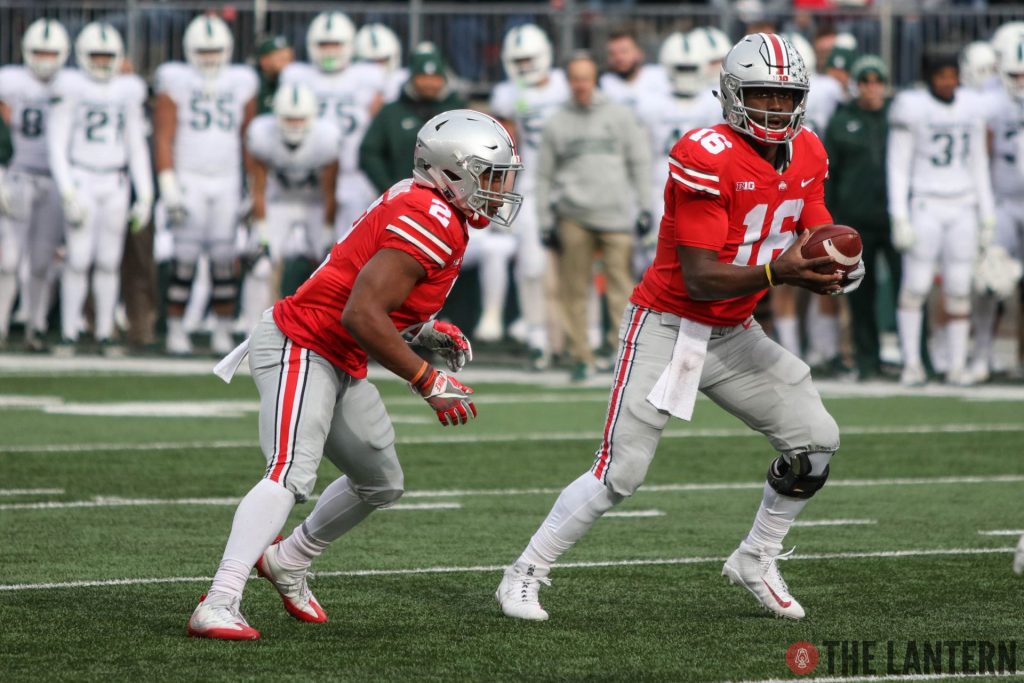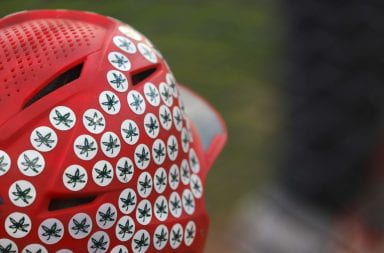
Ohio State redshirt senior quarterback J.T. Barrett (16) prepares to hand the ball off to freshman running back J.K. Dobbins (2) in the second half of the Ohio State-Michigan State game on Nov. 11. Ohio State won 48-3. Credit: Jack Westerheide | Photo Editor
“You don’t get hurt running straight ahead … three-yards-and-a-cloud-of-dust offense. I will pound you and pound you until you quit,” former Ohio State head coach Woody Hayes once said.
For years, that has been the mantra of Ohio State football. From Howard Cassady to Archie Griffin to Eddie George to Ezekiel Elliott, running backs have been the dominant force behind nearly every Ohio State championship-winning team.
Last week against Iowa, Ohio State abandoned that mentality. The Buckeyes rushed only 30 times and attempted 34 passes. They were blown out 55-24. Ohio State has passed more than it has rushed only three times this season, and two of those have been losses. Last season, the Buckeyes’ two games with the fewest rushes came against Penn State and Clemson, both losses.
Saturday, Ohio State returned to its roots. The No. 13 Buckeyes handed the football off 42 times and only attempted 23 passes. The result? A 48-3 blowout of the No. 12 Michigan State Spartans.
Quarterback J.T. Barrett said that after a loss, a team will try to rediscover its identity. For Ohio State, that identity comes on the ground.
“I feel like after a loss, you want to get back to what you’re good at, and establishing the run game,” Barrett said. “It definitely helps out with who we are in play-action pass and making our shots downfield. So just getting back to who you are, whether it be fundamentals or even when it comes to offensively and defensively making calls and things like that.”
Head coach Urban Meyer said Monday he had a conversation with running backs coach Tony Alford and co-offensive coordinator Kevin Wilson about running the ball more often. After the game, however, Meyer seemed to take a slightly different angle.
He said while there was a “mandate” to make sure his running backs were fed the ball, the reason the offense relied more heavily on them Saturday than against Iowa was more the result of dictating the flow of the game.
Regardless of the driving motive behind the heavier reliance on the run, the conversation shaped the gameplan heading into the team’s matchup against Michigan State. Freshman running back J.K. Dobbins said it became clear during the first practice of the week the team would lean heavier on the run.
“We told ourselves that we needed to be more physical, come off running the ball,” Dobbins said. “So that’s what we did.”
Dobbins makes it sound simple, but at least on paper, the matchup appeared to be anything but simple. Going into a game against a rushing defense that allowed the third-fewest rushing yards per game and fourth-fewest yards per carry, Ohio State had its work cut out for it.
Nonetheless, Ohio State seemed determined right out of the gate to test that defensive front with running backs Dobbins and redshirt sophomore Mike Weber.
Six plays into Ohio State’s first offensive drive of the game, Weber took the handoff from Barrett, made it three yards past the line of scrimmage and left the Spartans in a cloud of dust, racing 47 yards to the end zone.
It would not be the last time Weber picked up a touchdown with a big rush. He later burst into the end zone with 6:27 remaining in the second quarter for a career-long 82-yard rush to put the Buckeyes up 35-0.
By the time the dust had settled, Weber had finished the game with 162 yards and two touchdowns on nine carries, while Dobbins had 124 yards on 18 rush attempts. During the game, Dobbins joined Weber, Maurice Clarett and Robert Smith as the only Ohio State freshmen to rush for more than 1,000 yards in a season. Only Dobbins, Clarett and Smith were true freshmen.
The Buckeyes found little trouble running through the Michigan State defense, and Weber said it was a welcome relief for the team to again lean on the run.
“We went into the week going hard about running the ball because we haven’t really got the ball a lot this year, me and J.K.,” Weber said. “Coach Alford and coach Meyer did a good job saying we’re just going to pound the ball and it worked out for us.”
Ohio State found that good things happen when it leans on its dynamic pairing of running backs. This shouldn’t be breaking news for a program that has historically relied on the ground game.
Of the eight retired numbers in Ohio State history, only one, Troy Smith, fits the modern description of a quarterback. Five were running backs. Though Ohio State has always counted on quarterbacks in some capacity, the Buckeyes have traditionally been a program that has often viewed passing as a risk rather than the backbone of the offense.
“There are three things that can happen when you throw a pass, and two of them are bad,” Hayes once said.
Against Iowa, Ohio State threw the ball frequently, and the results were bad. The Buckeyes avoided that Saturday against the Spartans, and it resulted in one of their most dominating wins of the season.


